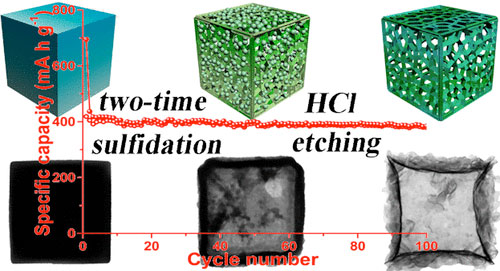| May 16, 2019 | |
Hollow MoS2 microcube framework with enhanced sodium storage properties(Nanowerk News) Sodium-ion batteries (SIBs) with the similar energy storage mechanism to lithium ion batteries (LIBs) have attracted increasing attention in light of the natural abundance and the environmental benignity. |
|
| However, the large ionic radius of Na+ makes the most common and commercial anode of LIBs - graphite anode - fail to guarantee well the rapid mass transport and alleviate the large internal strain/stress upon cycling owing to its insufficient interlayer spacing (∼0.34 nm). The main challenge for SIBs is to find appropriate electrode materials with good robustness that can well host large Na+ ions. | |
| In a study published in ACS Nano ("Hierarchical MoS2 Hollow Architectures with Abundant Mo Vacancies for Efficient Sodium Storage"), a research team led by Prof. ZHANG Jian at Fujian Institute of Research on the Structure of Matter of the Chinese Academy of Sciences developed a hollow microcubic framework (HMF) constructed by Mo-defect-rich ultrathin MoS2 nanosheets (HMF-MoS2) through a zeolite-like framework engaged strategy, which delivers a specific capacity (384.3 mA h g-1 after 100 cycles at 100 mA g-1) and cycle stability (267 mA h g-1 after 125 cycles at 1 A g-1) for sodium storage. | |
 |
|
| The synthesis of HMF-MoS and the enhanced sodium storage performance. (Image by Prof. ZHANG’s Group) | |
| Researchers found that the unique structural design and the boosted sodium adsorption by Mo defect are fundamental for achieving enhanced sodium storage of HMF-MoS2. In particular, the hierarchical hollow architecture with more exposed electrochemical active species endows HMF-MoS2 high specific capacity and large electrolyte/electrode contact area. | |
| Moreover, the hollow structure provides sufficient buffer space to accommodate the large volume expansion of MoS2 upon sodium intake. | |
| Density functional theory calculations demonstrated that the Mo defects can not only accelerate the charge transfer, but also lead to strong binging affinity for sodium. Kinetic analysis result revealed that the ultrafast sodium ion storage of HMF-MoS2 could be associated with the significant contribution of capacitive energy storage. | |
| This study detailed the molecular level understanding of chemical reaction on MoS2 surface by defect and morphology engineering, which can be applied to other metal sulfides for energy storage devices. |
| Source: Chinese Academy of Sciences | |
|
Subscribe to a free copy of one of our daily Nanowerk Newsletter Email Digests with a compilation of all of the day's news. |
